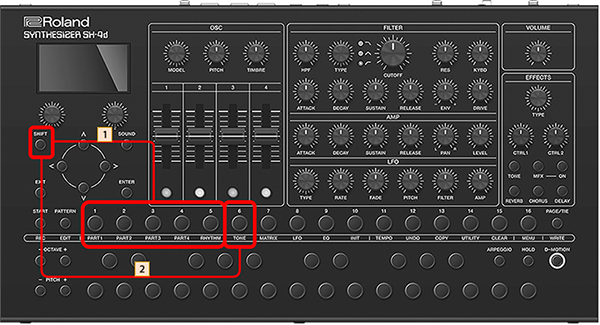Configuring a tone

- Hold down the [SHIFT] button and press the [1]–[5] buttons to select a tone part.
- Hold down the [SHIFT] button and press the [6] button.
- The TONE screen appears.

Parameter | Value | Explanation |
|---|---|---|
Level | 0–127 | Adjusts the overall volume for all tones. |
Octave | -3–+3 | Sets the pitch of the tone’s sound in octaves (up to ±3 octaves). |
Coarse Tune | -48–+48 | Specifies the pitch in semitone steps (maximum ±4 octaves). |
OSC 2 Coarse Tune | -48–+48 | Sets the pitch of oscillator 2 in semitones (only when using the SYNC model). |
Analog Feel | 0–127 | Applies time-varying change to the pitch and volume of the tone that is producing sound, adding a sense of variability. As you increase this value toward the maximum, the variability becomes greater, producing instability (only for the SH-4d, SH-3D, SYNC, SH-101, JUNO-106, Cross FM, RING, CHORD and PCM models). |
Mono Poly | Specifies whether the tone will play polyphonically (POLY) or monophonically (MONO). | |
MONO | Sound only the last-played key one at a time. | |
POLY | Two or more notes can be played simultaneously. | |
Legato Sw | OFF, ON | This is enabled when “Mono Poly” is set to “MONO”. With "Legato Sw" set to "ON", when you press the next key while still holding down the previous key (legato performance), the next note sounds without its attack portion. This lets you smoothly connect the pitches without a gap in the notes. |
Porta Sw | OFF, ON | Specifies whether the portamento effect will be applied (ON) or not applied (OFF).
By applying portamento when the MONO/POLY parameter is “MONO,” you can simulate slide performance techniques on a violin or similar instrument. |
Porta Mode | This sets the playing style for applying portamento. | |
NORMAL | Portamento is always applied. | |
LEGATO | Portamento is only applied when you play in legato style (playing one key and then playing the next while holding down the first one). | |
Porta Time | 0–1023 | When portamento is used, this sets the speed taken for the pitch to change. Higher settings cause the pitch change to take more time when gliding to the next note. |
Amp Velo Sense | -100–+100 | Set this when you want the volume of the tone to change depending on the force with which you press keys on an external keyboard. Set this to a positive (+) value to have the changes in volume increase the more forcefully the keys are played; to make the tone play more softly as you play harder, set this to a negative (-) value.
|
Cutoff Velo Sense | -100–+100 | Sets how much the cutoff frequency changes according to how hard you play the keys. Positive values make the cutoff frequency increase when you play the keys harder, and negative values make the cutoff frequency decrease. |
BendRange Up | 0–48 | Sets how much the pitch changes (in semitones) when the [PITCH +] button is pressed. For instance, a setting of “48” makes the pitch bend up four octaves when you press the [PITCH +] button. |
BendRange Dw | 0–48 | Sets how much the pitch changes (in semitones) when the [PITCH -] button is pressed. For instance, a setting of “48” makes the pitch bend down four octaves when you press the [PITCH -] button. |
Env Mode | ADR, ADSR | ADSR: Once the envelope passes its decay time, it stays at the sustain level until the note is released (note off). When the note is released (note off), the envelope then goes to its release segment from the current value. ADR: the envelope skips to its release segment once the decay time has passed, and the envelope operates according to its set time, regardless of when you release the note (note off). |
Catg | – | Sets the category for the tone. |